Photon Beam Transport and Scientific Instruments at the European XFEL
Abstract
:Featured Application
Abstract
1. Introduction
2. Overview European XFEL
2.1. Layout of the European XFEL Facility
2.2. The Super-Conducting Electron Accelerator
2.3. The FEL Undulator Sources
2.4. The Experiment Hall and Ancillary Instrumentation
2.4.1. Large Area Detectors for European XFEL
2.4.2. Optical Lasers for European XFEL
2.5. The User Program
2.6. European XFEL Governance and Organization
3. X-ray Photon Beam Transports
4. Photon Diagnostics Systems
4.1. Online Photon Diagnostic Systems
4.1.1. X-ray Gas Monitors
4.1.2. Photoelectron Spectrometer
4.1.3. The HIREX Spectrometer
4.2. Invasive Photon Diagnostics Systems
4.2.1. MCP Based Detector
4.2.2. Undulator Commissioning Spectrometer
4.2.3. Imagers
- Transmissive imagers (1 per FEL) are closest to the source and have the thinnest scintillators to allow transmitting the beam for recording another image of the same photon pulse at a downstream imager. By this method beam pointing and beam offset data can be obtained simultaneously.
- The SR imagers (1 per FEL) are optimized for highest photon sensitivity to detect spontaneous radiation from single undulator segments when applied in conjunction with the K-mono in undulator commissioning. Their optical resolution is 25 µm (FWHM) and field of view (FOV) 26.6 × 15 mm2 using YAG:Ce and ceramic Gd2O2S:Pr scintillators.
- The FEL imagers (1 per FEL) are optimized for detailed spatial characterization of the FEL beam to measure the transverse intensity profile with beam position, size and shape. Their optical resolution is 28 µm (FWHM) and FOV is 16 × 22 mm2. These imagers have redundancy scintillators of several different materials.
- Pop-in monitors (15 in total) are the basic imagers for beam finding and alignment. These monitors are placed downstream of major optical elements like mirrors and monochromators. Their horizontal FOV is large as to cover the variable beam offset without scintillator or optics movements. Various geometries are employed. Most devices put the scintillator at 45° to the XFEL beam, but some have the scintillator at normal incidence and an additional optical mirror. Optical resolutions range from 35 to 83 µm (FWHM) and FOVs from 22.7 × 40 up to 150 × 30 mm2.
- Exit slit imagers are installed on the two exit slits of the SASE3 monochromator for beam alignment, but more importantly to deliver single-pulse soft X-ray spectra with a resolution of ∆E/E ≥ 10−5.
5. The SPB/SFX Instrument
5.1. Scientific Scope and X-ray Techniques
5.2. Requirements
5.3. SPB/SFX Instrumentation and Capabilities
6. The FXE Instrument
6.1. Scientific Scope and X-ray Techniques
6.2. Requirements
6.3. FXE Instrumentation and Capabilities
7. The SQS Instrument
7.1. Scientific Scope and X-ray Techniques
7.2. Requirements
7.3. SQS Instrumentation and Capabilities
8. The SCS Instrument
8.1. Scientific Scope and X-ray Techniques
8.2. Requirements
8.3. SCS Instrumentation and Capabilities
9. The MID Instrument
9.1. Scientific Scope and X-ray Techniques
9.2. Requirements
9.3. MID Instrumentation and Capabilities
10. The HED Instrument
10.1. Scientific Scope and X-ray Techniques
10.2. Requirements
10.3. HED Instrumentation and Capabilities
11. Future Developments
Acknowledgments
Author Contributions
Conflicts of Interest
References
- Pellegrini, C.; Marinelli, A.; Reiche, S. The physics of X-ray free-electron lasers. Rev. Mod. Phys. 2016, 88, 015006. [Google Scholar] [CrossRef]
- Saldin, E.L.; Schneidmiller, E.V.; Yurkov, M.V. The Physics of Free-Electron Lasers, 1st ed.; Springer: Berlin, Germany, 1999. [Google Scholar]
- Ayvazyan, V.; Baboi, N.; Bähr, J.; Balandin, V.; Beutner, B.; Brandt, A.; Bohnet, I.; Bolzmann, A.; Brinkmann, R.; Brovko, O.I.; et al. First operation of a free-electron laser generating GW power radiation at 32 nm wavelength. Eur. Phys. J. D 2006, 37, 297–303. [Google Scholar] [CrossRef]
- Ackermann, W.; Asova, G.; Ayvazyan, V.; Azima, A.; Baboi, N.; Bähr, J.; Balandin, V.; Beutner, B.; Brandt, A.; Bolzmann, A.; et al. Operation of a free-electron laser from the extreme ultraviolet to the water window. Nat. Photonics 2007, 1, 336–342. [Google Scholar] [CrossRef]
- Emma, P.; Akre, R.; Arthur, J.; Bionta, R.; Bostedt, C.; Bozek, J.; Brachmann, A.; Bucksbaum, P.; Coffee, R.; Decker, F.-J.; et al. First lasing and operation of an Angstrom-wavelength free-electron laser. Nat. Photonics 2010, 4, 641–647. [Google Scholar] [CrossRef]
- Allaria, E.; Appio, R.; Badano, L.; Barletta, L.W.; Bassanese, S.; Biedron, S.G.; Borga, A.; Busetto, E.; Castronovo, D.; Cinquegrana, P.; et al. Highly coherent and stable pulses from the FERMI seeded free-electron laser in the extreme ultraviolet. Nat. Photonics 2012, 6, 699–704. [Google Scholar] [CrossRef]
- Ishikawa, T.; Aoyagi, H.; Asaka, T.; Asano, Y.; Azumi, Y.; Bizen, T.; Ego, H.; Fukami, K.; Fukui, T.; Furukawa, Y.; et al. A compact X-ray free-electron laser emitting in the sub-Ångström region. Nat. Photonics 2012, 6, 540–544. [Google Scholar] [CrossRef]
- Ko, I.S.; Kang, H.-S.; Heo, H.; Kim, C.; Kim, G.; Min, C.-K.; Yang, H.; Baek, S.Y.; Choi, H.-J.; Mun, G.; et al. Construction and Commissioning of PAL-XFEL Facility. Appl. Sci. 2017, 7, 479. [Google Scholar] [CrossRef]
- Patterson, B.D.; Abela, R.; Braun, H.-H.; Flechsig, U.; Ganter, R.; Kim, Y.; Kirk, E.; Oppelt, A.; Pedrozzi, M.; Reiche, S.; et al. Coherent science at the SwissFEL X-ray laser. New J. Phys. 2010, 12, 035012. [Google Scholar] [CrossRef]
- Altarelli, M.; Brinkmann, R.; Chergui, M.; Decking, W.; Dobson, B.; Düsterer, S.; Grübel, G.; Graeff, W.; Graafsma, H.; Hajdu, J.; et al. (Eds.) XFEL: The European X-ray Free-Electron Laser—Technical Design Report; DESY 2006-097; DESY: Hamburg, Germany, 2006. [Google Scholar] [CrossRef]
- Altarelli, A. The European X-ray free-electron laser facility in Hamburg. Nucl. Instrum. Methods Phys. Res. B 2011, 269, 2845–2849. [Google Scholar] [CrossRef]
- Flöttmann, K.; Rossbach, J.; Schmüser, P.; Walker, N.; Weise, H.; Brinkmann, R. (Eds.) TESLA Technical Design Report—Part II: The Accelerator; DESY 2001-011; DESY: Hamburg, Germany, 2001. [Google Scholar]
- Galayda, J.N. The New LCLS-II project: Status and Challenges. In Proceedings of the LINAC 2014 Conference, Geneva, Switzerland, 31 August–5 September 2014. [Google Scholar]
- Brinkmann, R.; Faatz, B.; Flöttmann, K.; Rossbach, J.; Schneider, J.R.; Schulte-Schrepping, H.; Trines, D.; Tschentscher, Th.; Weise, H. (Eds.) Design Report: First Stage of the TESLA XFEL Laboratory; DESY 2002-167; DESY: Hamburg, Germany, 2002. [Google Scholar]
- Decking, W.; Limberg, T. European XFEL Post-TDR Description; XFEL.EU TN-2013-004; European XFEL: Hamburg, Germany, 2013. [Google Scholar]
- Vartanyants, I.A.; Robinson, I.K.; McNulty, I.; David, C.; Wochner, P.; Tschentscher, Th. Coherent X-ray scattering and lensless imaging at the European XFEL Facility. J. Synchrotron Radiat. 2007, 14, 453–470. [Google Scholar] [CrossRef] [PubMed]
- Kimberg, V.; Sanchez-Gonzalez, A.; Mercadier, L.; Weninger, C.; Lutman, A.; Ratner, D.; Coffee, R.; Bucher, M.; Mucke, M.; Agaker, M.; et al. Stimulated X-ray Raman scattering—A critical assessment of the building block of nonlinear X-ray spectroscopy. Faraday Discuss. 2016, 194, 305–324. [Google Scholar] [CrossRef] [PubMed]
- Grübel, G.; Stephenson, G.B.; Gutt, C.; Sinn, H.; Tschentscher, Th. XPCS at the European X-ray free electron laser facility. Nucl. Instrum. Methods Phys. Res. B 2007, 262, 357–367. [Google Scholar] [CrossRef]
- Krasilnikov, M.; Stephan, F.; Asova, G.; Grabosch, H.-J.; Groß, M.; Hakobyan, L.; Isaev, I.; Ivanisenko, Y.; Jachmann, L.; Khojoyan, M.; et al. Experimentally minimized beam emittance from an L-band photoinjector. Phys. Rev. ST Accel. Beams 2012, 15, 100701. [Google Scholar] [CrossRef]
- Rimjaem, S.; Stephan, F.; Krasilnikov, M.; Ackermann, W.; Asova, G.; Bähr, J.; Gjonaj, E.; Grabosch, H.J.; Hakobyan, L.; Hänel, M.; et al. Optimizations of transverse projected emittance at the photo-injector test facility at DESY, location Zeuthen. Nucl. Instrum. Methods Phys. Res. A 2012, 671, 62–75. [Google Scholar] [CrossRef]
- Brinker, F. Commissioning of the European XFEL Injector. In Proceedings of the 7th International Particle Accelerator Conference (IPAC’16), Busan, Korea, 8–13 May 2016. [Google Scholar]
- Decking, W.; Weise, H. Commissioning of the European XFEL. In Proceedings of the International Particle Accelerator Conference 2017, Copenhagen, Denmark, 14–19 May 2017. [Google Scholar]
- Nölle, D. Commissioning of the European XFEL Facility. In Proceedings of the SPIE, X-ray Free-Electron Lasers: Advances in Source Development and Instrumentation, Prague, Czech Republic, 24–27 April 2017; Volume 10237. [Google Scholar]
- Li, Y.; Abeghyan, S.; Berndgen, K.; Baha-Shanjani, M.; Deron, G.; Englisch, U.; Karabekyan, S.; Ketenoglu, B.; Knoll, M.; Wolff-Fabris, F.; et al. Magnetic Measurement Techniques for the Large-Scale Production of Undulator Segments for the European XFEL. Synchrotron Radiat. News 2015, 28, 23–28. [Google Scholar] [CrossRef]
- Pflüger, J.; Lu, H.; Teichmann, T. Field fine tuning by pole height adjustment for the undulator of the TTF-FEL. Nucl. Instrum. Methods Phys. Res. A 1999, 429, 386–391. [Google Scholar] [CrossRef]
- Schneidmiller, E.A.; Yurkov, M.V. An Overview of the Radiation Properties of the European XFEL. In Proceedings of the FEL 2014 Conference, Basel, Switzerland, 5–29 August 2014. [Google Scholar]
- Schneidmiller, E.A.; Yurkov, M.V. Photon Beam Properties at the European XFEL, December 2010 Revision ed; Preprint DESY 11-152; DESY: Hamburg, Germany, 2011. [Google Scholar]
- Kuster, M.; Boukhelef, D.; Donato, M.; Dambietz, J.-S.; Hauf, S.; Maia, L.; Raab, N.; Szuba, J.; Turcato, M.; Wrona, K.; et al. Detectors and Calibration Concept for the European XFEL. Synchrotron Radiat. News 2014, 27, 35–38. [Google Scholar] [CrossRef]
- Raab, N.; Ballak, K.-E.; Dietze, T.; Ekmedzic, M.; Hauf, S.; Januschek, F.; Kaukher, A.; Kuster, M.; Lang, P.M.; Münnich, A.; et al. Status of the laboratory infrastructure for detector calibration and characterization at the European XFEL. J. Instrum. 2016, 11, C12051. [Google Scholar] [CrossRef]
- Mozzanica, A.; Bergamaschi, A.; Dinapoli, R.; Graafsma, H.; Greiffenberg, D.; Henrich, B.; Johnson, I.; Lohmann, M.; Valeria, R.; Schmitt, B. The GOTTHARD charge integrating readout detector: Design and characterization. J. Instrum. 2012, 7, C01019. [Google Scholar] [CrossRef]
- Henrich, B.; Becker, J.; Dinapoli, R.; Goettlicher, P.; Graafsma, H.; Hirsemann, H.; Klanner, R.; Krueger, H.; Mazzocco, R.; Mozzanica, A.; et al. The adaptive gain integrating pixel detector AGIPD a detector for the European XFEL. Nucl. Instrum. Methods Phys. Res. A 2011, 633, S11–S14. [Google Scholar] [CrossRef]
- Koch, A.; Hart, M.; Nicholls, T.; Angelsen, C.; Coughlan, J.; French, M.; Hauf, S.; Kuster, M.; Sztuk-Dambietz, J.; Turcato, M.; et al. Performance of an LPD prototype detector at MHz frame rates under Synchrotron and FEL radiation. J. Instrum. 2013, 8, C11001. [Google Scholar] [CrossRef]
- Porro, M.; Andricek, L.; Bombelle, L.; De Vita, G.; Fiorini, C.; Fischer, P.; Hansen, K.; Lechner, P.; Lutz, G.; Strüder, L.; et al. Expected performance of the DEPFET sensor with signal compression: A large format X-ray imager with mega-frame readout capability for the European XFEL. Nucl. Instrum. Methods Phys. Res. A 2010, 624, 509–519. [Google Scholar] [CrossRef]
- Pergament, M.; Kellert, M.; Kruse, K.; Wang, J.; Palmer, G.; Wissmann, L.; Wegner, U.; Lederer, M.J. High power burst-mode optical parametric amplifier with arbitrary pulse selection. Opt. Express 2014, 22, 22202–22210. [Google Scholar] [CrossRef] [PubMed]
- Pergament, M.; Palmer, G.; Kellert, M.; Kruse, K.; Wang, J.; Wissmann, L.; Wegner, U.; Emons, M.; Kane, D.; Priebe, G.; et al. Versatile optical laser system for experiments at the European X-ray Free-Electron Laser Facility. Opt. Express 2016, 24, 29349–29359. [Google Scholar] [CrossRef] [PubMed]
- Sydlo, C.; Czwalinna, M.; Felber, M.; Gerth, C.; Jabłoński, S.; Müller, J.; Schlarb, H.; Zummack, F. Femtosecond Timing Distribution at the European XFEL. In Proceedings of the 7th International Particle Accelerator Conference (IPAC’16), Busan, Korea, 8–13 May 2016. [Google Scholar]
- Schulz, S.; Grguras, I.; Behrens, C.; Bromberger, H.; Costello, J.T.; Czwalinna, M.K.; Felber, M.; Hoffmann, M.C.; Ilchen, M.; Liu, H.Y.; et al. Femtosecond all-optical synchronization of an X-ray free-electron laser. Nat. Commun. 2015, 6, 5938. [Google Scholar] [CrossRef] [PubMed]
- Sinn, H.; Gaudin, J.; Samoylova, L.; Trapp, A; Galasso, G. Conceptual Design Report: X-ray Optics and Beam Transport; XFEL.EU TR-2011-002; European XFEL: Hamburg, Germany, 2011. [Google Scholar] [CrossRef]
- Sinn, H.; Dommach, M.; Dong, X.; La Civita, D.; Samoylova, L.; Villanueva, R.; Yang, F. Technical Design Report: X-ray Optics and Beam Transport; XFEL.EU TR-2012-006; European XFEL: Hamburg, Germany, 2012. [Google Scholar] [CrossRef]
- Geloni, G.; Saldin, E.; Samoylova, L.; Schneidmiller, E.; Sinn, H.; Tschentscher, Th.; Yurkov, M. Coherence properties of the European XFEL. New J. Phys. 2010, 12, 035021. [Google Scholar] [CrossRef]
- Grünert, J. Conceptual Design Report: Framework for X-ray Photon Diagnostics at the European XFEL; XFEL.EU TR-2012-003; European XFEL: Hamburg, Germany, 2012. [Google Scholar] [CrossRef]
- Grünert, J.; Buck, J.; Ozkan, C.; Freund, W.; Molodtsov, S. X-ray Photon Diagnostics Devices for the European XFEL. In Proceedings of the SPIE, X-ray Free-Electron Lasers: Beam Diagnostics, Beamline Instrumentation, and Applications, San Diego, CA, USA, 12 August 2012. [Google Scholar] [CrossRef]
- Grünert, J.; Buck, J.; Freund, W.; Ozkan, C.; Molodtsov, S. Development status of the X-ray beam diagnostics devices for the commissioning and user operation of the European XFEL. J. Phys. Conf. Ser. 2013, 425, 072004. [Google Scholar] [CrossRef]
- Gruenert, J.; Koch, A.; Kujala, N.; Freund, V.; Planas, M.; Dietrich, F.; Buck, J.; Liu, J.; Sinn, H.; Dommach, M. Photon Diagnostics and Photon Beamlines Installations at the European XFEL. In Proceedings of the 37th International Free-Electron Laser Conference 2015, Daejeon, Korea, 23–28 August 2015. [Google Scholar]
- Liu, J. Requirements and Concept for the Characterization of Photon Beam Temporal Properties at the SQS Scientific Instrument of the European XFEL Facility; XFEL.EU TN-2015-002-01; European XFEL: Hamburg, Germany, 2015. [Google Scholar]
- Liu, J.; Dietrich, F.; Grünert, J. Technical Design Report: Photon Arrival Time Monitor (PAM) at the European XFEL; XFEL.EU TR-2017-002; European XFEL: Schenefeld, Germany, 2017. [Google Scholar]
- Maltezopoulos, Th.; Cunovic, S.; Wieland, M.; Beye, M.; Azima, A.; Redlin, H.; Krikunova, M.; Kalms, R.; Frühling, U.; Budzyn, F.; et al. Single-shot timing measurement of extreme-ultraviolet free-electron laser pulses. New J. Phys. 2008, 10, 033026. [Google Scholar] [CrossRef]
- Grguras, I.; Maier, A.R.; Behrens, C.; Mazza, T.; Kelly, T.J.; Radcliffe, P.; Düsterer, S.; Kazansky, A.K.; Kabachnik, N.M.; Tschentscher, Th.; et al. Ultrafast X-ray pulse characterization at free-electron lasers. Nat. Photonics 2012, 6, 852–857. [Google Scholar] [CrossRef]
- Harmand, M.; Coffee, R.; Bionta, M.R.; Chollet, M.; French, D.; Zhu, D.; Fritz, D.M.; Lemke, H.T.; Medvedev, N.; Ziaja, B.; et al. Achieving few-femtosecond time-sorting at hard X-ray free-electron lasers. Nat. Photonics 2013, 7, 215–218. [Google Scholar] [CrossRef]
- Hartmann, N.; Helml, W.; Galler, A.; Bionta, M.R.; Grünert, J.; Molodtsov, S.L.; Ferguson, K.R.; Schorb, S.; Swiggers, M.L.; Carron, S.; et al. Sub-femtosecond precision measurement of relative X-ray arrival time for free-electron lasers. Nat. Photonics 2014, 8, 706–709. [Google Scholar] [CrossRef]
- Tiedtke, K.; Feldhaus, J.; Hahn, U.; Jastrow, U.; Nunez, T.; Tschentscher, Th.; Bobashev, S.V.; Sorokin, A.A.; Hastings, J.B.; Möller, S.; et al. Gas-detector for X-ray lasers. J. Appl. Phys. 2008, 103, 094511. [Google Scholar] [CrossRef]
- Feng, Y.; Raubenheimer, T.O. Duty-Cycle Dependence of the Filamentation Effect in Gas Devices for High Repetition Rate Pulsed X-ray FEL’s. In Proceedings of the SPIE, X-ray Free-Electron Lasers: Advances in Source Development and Instrumentation, Prague, Czech Republic, 24–27 April 2017; Volume 10237. [Google Scholar]
- Tono, K.; Kudo, T.; Yabashi, M.; Tachibana, T.; Feng, Y.; Fritz, D.; Hastings, J.; Ishikawa, T. Single-shot beam-position monitor for X-ray free electron laser. Rev. Sci. Instrum. 2011, 82, 023108. [Google Scholar] [CrossRef] [PubMed]
- Zhu, D.; Cammarata, M.; Feldkamp, J.M.; Fritz, D.M.; Hastings, J.B.; Lee, S.; Lemke, H.T.; Robert, A.; Turner, J.L.; Feng, Y. A single-shot transmissive spectrometer for hard X-ray free electron lasers. Appl. Phys. Lett. 2012, 101, 034103. [Google Scholar] [CrossRef]
- Buck, J. Conceptual Design Report: Online Time-of-Flight Photoemission Spectrometer for X-ray Photon Diagnostics; XFEL.EU TR-2012-002; European XFEL: Hamburg, Germany, 2012. [Google Scholar] [CrossRef]
- Lutman, A.A.; MacArthur, J.P.; Ilchen, M.; Lindahl, A.O.; Buck, J.; Coffee, R.N.; Dakovski, G.L.; Dammann, L.; Ding, Y.; Dürr, H.A.; et al. Polarization control in an X-ray free-electron laser. Nat. Photonics 2016, 10, 468–472. [Google Scholar] [CrossRef]
- Syresin, E.; Brovko, O.; Kapishin, M.; Shabunov, A.; Yurkov, M.; Freund, W.; Gruenert, J.; Sinn, H. Development of MCP Based Photon Detectors for the European XFEL. In Proceedings of the International Particle Accelerator Conference 2011, San Sebastian, Spain, 4–9 September 2011. [Google Scholar]
- Freund, W. The Undulator Commissioning Spectrometer for the European XFEL, XFEL.EU Technical Report; XFEL.EU TN-2014-001-01; European XFEL: Hamburg, Germany, 2013. [Google Scholar]
- Ozkan, C.; Freund, W.; Rehanek, J.; Buck, J.; Zizak, I.; Gruenert, J.; Schaefers, F.; Erko, A.; Molodtsov, S. Initial Evaluation of the European XFEL Undulator Commissioning Spectrometer with a Single Channel-Cut Crystal. In Proceedings of the SPIE, X-ray Free-Electron Lasers: Beam Diagnostics, Beamline Instrumentation, and Applications, San Diego, CA, USA, 12 August 2012; Volume 8504. [Google Scholar] [CrossRef]
- Ozkan, C. Conceptual Design Report: Imaging Stations for Invasive Photon Diagnostics; XFEL.EU TR-2012-004; European XFEL: Hamburg, Germany, 2012. [Google Scholar]
- Mancuso, A.P.; Aquila, A.L.; Borchers, G.; Giewekemeyer, K.; Reimers, N. Technical Design Report: Scientific Instrument Single Particles, Clusters, and Biomolecules (SPB); XFEL.EU TR-2013-004; European XFEL: Hamburg, Germany, 2013. [Google Scholar] [CrossRef]
- Garman, E.F. Developments in X-ray Crystallographic Structure Determination of Biological Macromolecules. Science 2014, 343, 1102–1108. [Google Scholar] [CrossRef] [PubMed]
- Spence, J.C.H.; Weierstall, U.; Chapman, H.N. X-ray lasers for structural and dynamic biology. Rep. Prog. Phys. 2012, 75, 102601. [Google Scholar] [CrossRef] [PubMed]
- Schlichting, I. Serial femtosecond crystallography: The first five years. IUCrJ 2015, 2, 246–255. [Google Scholar] [CrossRef] [PubMed]
- White, T.A.; Kirian, R.A.; Martin, A.V.; Aquila, A.; Nass, K.; Barty, A.; Chapman, H.N. CrystFEL: A software suite for snapshot serial crystallography. J. Appl. Crystallogr. 2012, 45, 335–341. [Google Scholar] [CrossRef]
- Loh, N.-T.D.; Elser, V. Reconstruction algorithm for single-particle diffraction imaging experiments. Phys. Rev. E 2009, 80, 026705. [Google Scholar] [CrossRef] [PubMed]
- Barends, T.R.M.; Foucar, L.; Botha, S.; Doak, R.B.; Shoeman, R.L.; Nass, K.; Koglin, J.E.; Williams, G.J.; Boutet, S.; Messerschmidt, M.; et al. De novo protein crystal structure determination from X-ray free-electron laser data. Nature 2015, 505, 244–247. [Google Scholar] [CrossRef] [PubMed]
- Schwander, P.; Fung, R.; Phillips, G.N.; Ourmazd, A. Mapping the conformations of biological assemblies. New J. Phys. 2010, 12, 035007. [Google Scholar] [CrossRef]
- Aquila, A.; Sobierajski, R.; Ozkan, C.; Hajkova, V.; Burian, T.; Chalupský, J.; Juha, L.; Störmer, M.; Bajt, S.; Klepka, M.T.; et al. Fluence thresholds for grazing incidence hard X-ray mirrors. Appl. Phys. Lett. 2015, 106, 241905. [Google Scholar] [CrossRef]
- Bean, R.J.; Aquila, A.; Samoylova, L.; Mancuso, A.P. Design of the mirror optical systems for coherent diffractive imaging at the SPB/SFX instrument of the European XFEL. J. Opt. 2016, 18, 1–10. [Google Scholar] [CrossRef]
- Bressler, Ch.; Galler, A.; Gawelda, W. Technical Design Report: Scientific Instrument FXE; XFEL.EU TR-2012-008; European XFEL: Hamburg, Germany, 2012. [Google Scholar] [CrossRef]
- Cho, H.S.; Dashdorj, N.D.; Schotte, F.; Graber, T.; Henning, R.; Anfinrud, P. Protein structural dynamics in solution unveiled via 100-ps time-resolved X-ray scattering. Proc. Natl. Acad. Sci. USA 2010, 107, 7281–7286. [Google Scholar] [CrossRef] [PubMed]
- Brefuel, N.; Watanabe, H.; Toupet, L.; Come, J.; Matsumoto, N.; Collet, E.; Tanaka, K.; Tuchagues, J.P. Concerted Spin Crossover and Symmetry Breaking Yield Three Thermally and One Light-Induced Crystallographic Phases of a Molecular Material. Angew. Chem. Int. Ed. 2013, 48, 9304–9307. [Google Scholar] [CrossRef] [PubMed]
- Smolentsev, G.; Sundström, V. Time-resolved X-ray absorption spectroscopy for the study of molecular systems relevant for artificial photosynthesis. Coord. Chem. Rev. 2015, 304, 117–132. [Google Scholar] [CrossRef]
- Torres-Alacan, J.; Lindner, J.; Vöhringer, P. Probing the Primary Photochemical Processes of Octahedral Iron(V) Formation with Femtosecond Mid-Infrared Spectroscopy. Chem. Phys. Chem. 2015, 16, 2289–2293. [Google Scholar] [CrossRef] [PubMed]
- Zhang, W.; Alonso-Mori, R.; Bergmann, U.; Bressler, C.; Chollet, M.; Galler, A.; Gawelda, W.; Hadt, R.G.; Hartsock, R.W.; Kroll, T.; et al. Tracking excited-state charge and spin dynamics in iron coordination complexes. Nature 2014, 509, 345–348. [Google Scholar] [CrossRef] [PubMed]
- Haldrup, K.; Gawelda, W.; Abela, R.; Alonso-Mori, R.; Bergmann, U.; Bordage, A.; Cammarata, M.; Canton, S.; Dohn, A.O.; van Driel, T.B. Observing Solvatiuon Dynamics with Simultaneous Femtosecond X-ray Emission Spectroscopy and X-ray Scattering. J. Phys. Chem. B 2016, 120, 1158–1168. [Google Scholar] [CrossRef] [PubMed]
- Katayama, T.; Owada, S.; Togashi, T.; Ogawa, K.; Karvinen, P.; Vartiainen, I.; Eronen, A.; David, C.; Sato, T.; Nakajima, K.; et al. A beam branching method for timing and spectral characterization of hard X-ray free electron lasers. Struct. Dyn. 2016, 3, 034301. [Google Scholar] [CrossRef] [PubMed]
- Mazza, T.; Zhang, H.; Meyer, M. Technical Design Report: Scientific Instrument SQS; XFEL.EU TR-2012-007; European XFEL: Hamburg, Germany, 2012. [Google Scholar] [CrossRef]
- Ullrich, J.; Moshammer, R.; Dorn, A.; Dörner, R.; Schmidt, H.L.P.; Schmidt-Böcking, H. Recoil-ion and electron momentum spectroscopy reaction-microscopes. Rep. Prog. Phys. 2003, 66, 1463–1545. [Google Scholar] [CrossRef]
- De Jong, S.; Kukreja, R.; Trabant, C.; Pontius, N.; Chang, C.F.; Kachel, T.; Beye, M.; Sorgenfrei, F.; Back, C.H.; Bräuer, B.; et al. Speed limit of the insulator–metal transition in magnetite. Nat. Mater. 2013, 12, 882–886. [Google Scholar] [CrossRef] [PubMed]
- Kubacka, T.; Johnson, J.A.; Hoffmann, M.C.; Vicario, C.; de Jong, S.; Beaud, P.; Grübel, S.; Huang, S.-W.; Huber, L.; Patthey, L.; et al. Large-Amplitude Spin Dynamics Driven by a THz Pulse in Resonance with an Electromagnon. Science 2014, 343, 1333–1336. [Google Scholar] [CrossRef] [PubMed]
- Först, M.; Caviglia, A.D.; Scherwitzl, R.; Mankowsky, R.; Zubko, P.; Khanna, V.; Bromberger, H.; Wilkins, S.B.; Chuang, Y.-D.; Lee, W.S.; et al. Spatially resolved ultrafast magnetic dynamics initiated at a complex oxide heterointerface. Nat. Mater. 2015, 14, 883–888. [Google Scholar] [CrossRef] [PubMed]
- Graves, C.E.; Reid, A.H.; Wang, T.; Wu, B.; de Jong, S.; Vahaplar, K.; Radu, I.; Bernstein, D.P.; Messerschmidt, M.; Müller, L.; et al. Nanoscale spin reversal by non-local angular momentum transfer following ultrafast laser excitation in ferrimagnetic GdFeCo. Nat. Mater. 2013, 12, 293–298. [Google Scholar] [CrossRef] [PubMed]
- Vodungbo, B.; Tudu, B.; Perron, J.; Delaunay, R.; Müller, L.; Berntsen, M.H.; Grübel, G.; Malinowski, G.; Weier, C.; Gautier, J.; et al. Indirect excitation of ultrafast demagnetization. Sci. Rep. 2016, 6, 18970. [Google Scholar] [CrossRef] [PubMed]
- Öström, H.; Öberg, H.; Xin, H.; LaRue, J.; Beye, M.; Dell’Angela, M.; Gladh, J.; Ng, M.L.; Sellberg, J.A.; Kaya, S.; et al. Probing the transition state region in catalytic CO oxidation on Ru. Science 2015, 347, 978–982. [Google Scholar] [CrossRef] [PubMed]
- Wernet, Ph.; Kunnus, K.; Josefsson, I.; Rajkovic, I.; Quevedo, W.; Beye, M.; Schreck, S.; Grubel, S.; Scholz, M.; Nordlund, D.; et al. Orbital-specific mapping of the ligand exchange dynamics of Fe(CO)5 in solution. Nature 2015, 520, 78–81. [Google Scholar] [CrossRef] [PubMed]
- Beye, M.; Schreck, S.; Sorgenfrei, F.; Trabant, C.; Pontius, N.; Schüßler-Langeheine, C.; Wurth, W.; Fohlisch, A. Stimulated X-ray emission for materials science. Nature 2013, 501, 191–194. [Google Scholar] [CrossRef] [PubMed]
- Higley, D.J.; Hirsch, K.; Dakovski, G.L.; Jal, E.; Yuan, E.; Liu, T.; Lutman, A.A.; MacArthur, J.P.; Arenholz, E.; Chen, Z.; et al. Femtosecond X-ray magnetic circular dichroism absorption spectroscopy at an X-ray free electron laser. Rev. Sci. Instrum. 2016, 87, 033110. [Google Scholar] [CrossRef] [PubMed]
- Eisebitt, S.; Luning, J.; Schlotter, W.F.; Lorgen, M.; Hellwig, O.; Eberhardt, W.; Stohr, J. Lensless imaging of magnetic nanostructures by X-ray spectro-holography. Nature 2004, 432, 885–888. [Google Scholar] [CrossRef] [PubMed]
- Liu, T.-M.; Wang, T.; Reid, A.H.; Savoini, M.; Wu, X.; Koene, B.; Granitzka, P.; Graves, C.E.; Higley, D.J.; Chen, Z.; et al. Nanoscale Confinement of All-Optical Magnetic Switching in TbFeCo—Competition with Nanoscale Heterogeneity. Nano Lett. 2015, 15, 6862–6868. [Google Scholar] [CrossRef] [PubMed]
- Scherz, A.; Krupin, O.; Buck, J.; Gerasimova, N.; Palmer, G.; Poolton, N.; Samoylova, L. Conceptual Design Report: Scientific Instrument Spectroscopy and Coherent Scattering (SCS); XFEL.EU TR-2013-006; European XFEL: Hamburg, Germany, 2013. [Google Scholar] [CrossRef]
- Wang, T.; Zhu, D.; Wu, B.; Graves, C.; Schaffert, S.; Rander, T.; Müller, L.; Vodungbo, B.; Baumier, C.; Bernstein, D.P.; et al. Femtosecond Single-Shot Imaging of Nanoscale Ferromagnetic Order in Co/Pd Multilayers Using Resonant X-ray Holography. Phys. Rev. Lett. 2012, 108, 267403. [Google Scholar] [CrossRef] [PubMed]
- Miao, J.; Ishikawa, T.; Robinson, I.K.; Murnane, M.M. Beyond crystallography: Diffractive imaging using coherent X-ray light sources. Science 2015, 348, 530–535. [Google Scholar] [CrossRef] [PubMed]
- Clark, J.; Beitra, L.; Xiong, G.; Higginbotham, A.; Fritz, D.M.; Lemke, H.T.; Zhu, D.; Chollet, M.; Williams, G.J.; Messerschmidt, M.; et al. Ultrafast Three-Dimensional Imaging of Lattice Dynamics in Individual Gold Nanocrystals. Science 2013, 341, 56–59. [Google Scholar] [CrossRef] [PubMed]
- Madsen, A.; Fluerasu, A.; Ruta, B. Structural Dynamics of Materials Probed by X-ray Photon Correlation Spectroscopy. In Synchrotron Light Sources and Free-Electron Lasers. Accelerator Physics, Instrumentation and Science Applications, 1st ed.; Jaeschke, E., Khan, S., Schneider, J.R., Hastings, J.B., Eds.; Springer: Berlin, Germany, 2016; pp. 1617–1641. [Google Scholar]
- Carnis, J.; Cha, W.; Wingert, J.; Kang, J.; Jiang, Z.; Song, S; Sikorski, M.; Robert, A.; Gutt, C.; Chen, S.-W.; et al. Demonstration of Feasibility of X-ray Free Electron Laser Studies of Dynamics of Nanoparticles in Entangled Polymer Melts. Sci. Rep. 2014, 4, 6017. [Google Scholar] [CrossRef] [PubMed]
- Lehmkühler, F.; Kwasniewski, P.; Roseker, W.; Fischer, B.; Schroer, M.A.; Tono, K.; Katayama, T.; Sprung, M.; Sikorski, M.; Song, S.; et al. Sequential Single Shot X-ray Photon Correlation Spectroscopy at the SACLA Free Electron Laser. Sci. Rep. 2015, 5, 17193. [Google Scholar] [CrossRef] [PubMed]
- Singer, A.; Patel, S.K.K.; Kukreja, R.; Uhlir, V.; Wingert, J.; Festersen, S.; Zhu, D.; Glownia, J.M.; Lemke, H.T.; Nelson, S.; et al. Photoinduced Enhancement of the Charge Density Wave Amplitude. Phys. Rev. Lett. 2016, 117, 056401. [Google Scholar] [CrossRef] [PubMed]
- Trigo, M.; Fuchs, M.; Chen, J.; Jiang, M.P.; Cammarata, M.; Fahy, S.; Fritz, D.M.; Gaffney, K.; Ghimire, S.; Higginbotham, A.; et al. Fourier-transform inelastic X-ray scattering from time- and momentum-dependent phonon–phonon correlations. Nat. Phys. 2013, 9, 790. [Google Scholar] [CrossRef]
- Liang, M.; Williams, G.J.; Messerschmidt, M.; Seibert, M.M.; Montanez, P.A.; Hayes, M.; Milathianaki, D.; Aquila, A.; Hunter, M.S.; Koglin, J.S.; et al. The Coherent X-ray Imaging instrument at the Linac Coherent Light Source. J. Synchrotron Radiat. 2015, 22, 514. [Google Scholar] [CrossRef] [PubMed]
- Nagler, B.; Schropp, A.; Galtier, E.C.; Arnold, B.; Brown, S.B.; Fry, A.; Gleason, A.; Granados, E.; Hashim, A.; Hastings, J.B.; et al. The phase-contrast imaging instrument at the matter in extreme conditions endstation at LCLS. Rev. Sci. Instrum. 2016, 87, 103701. [Google Scholar] [CrossRef] [PubMed]
- Wochner, P.; Gutt, C.; Autenrieth, T.; Demmer, T.; Bugaev, V.; Ortiz, A.D.; Duri, A.; Zontone, F.; Grübel, G.; Dosch, H. X-ray cross correlation analysis uncovers hidden local symmetries in disordered matter. Proc. Natl. Acad. Sci. USA 2009, 106, 11511. [Google Scholar] [CrossRef] [PubMed]
- Geloni, G.; Kocharyan, V.; Saldin, E. A novel self-seeding scheme for hard X-ray FELs. J. Mod. Opt. 2011, 58, 1391. [Google Scholar] [CrossRef]
- Amann, J.; Berg, W.; Blank, V.; Decker, F.-J.; Ding, Y.; Emma, P.; Feng, Y.; Frisch, J.; Fritz, D.; Hastings, J.; et al. Demonstration of self-seeding in a hard-X-ray free-electron laser. Nat. Photonics 2012, 6, 693. [Google Scholar] [CrossRef]
- Chubar, O.; Geloni, G.; Kocharyan, V.; Madsen, A.; Saldin, E.; Serkez, S.; Shvyd’ko, Y.; Sutter, J. Ultra-high-resolution inelastic X-ray scattering at high-repetition-rate self-seeded X-ray free-electron lasers. J. Synchrotron Radiat. 2016, 23, 410. [Google Scholar] [CrossRef] [PubMed]
- Roseker, W.; Franz, H.; Schulte-Schrepping, H.; Ehnes, A.; Leupold, O.; Zontone, F.; Lee, S.; Robert, A.; Grübel, G. Development of a hard X-ray delay line for X-ray photon correlation spectroscopy and jitter-free pump–probe experiments at X-ray free-electron laser sources. J. Synchrotron Radiat. 2011, 18, 481. [Google Scholar] [CrossRef] [PubMed]
- Osaka, T.; Hirano, T.; Sano, Y.; Inubushi, Y.; Matsuyama, S.; Tono, K.; Ishikawa, T.; Yamauchi, K.; Yabashi, M. Wavelength-tunable split-and-delay optical system for hard X-ray free-electron lasers. Opt. Express 2016, 24, 9187. [Google Scholar] [CrossRef] [PubMed]
- Lu, W.; Noll, T.; Roth, T.; Agapov, I.; Geloni, G.; Holler, M.; Hallmann, J.; Ansaldi, G.; Eisebitt, S.; Madsen, A. Design and throughput simulations of a hard X-ray split and delay line for the MID station at the European XFEL. AIP Conf. Proc. 2016, 1741, 030010. [Google Scholar] [CrossRef]
- Gutt, C.; Stadler, L.-M.; Duri, A.; Autenrieth, T.; Leupold, O.; Chushkin, Y.; Grübel, G. Measuring temporal speckle correlations at ultrafast X-ray sources. Opt. Express 2009, 17, 55. [Google Scholar] [CrossRef] [PubMed]
- Bandyopadhyay, R.; Gittings, A.S.; Suh, S.S.; Dixon, P.K.; Durian, D.J. Speckle-visibility spectroscopy: A tool to study time-varying dynamics. Rev. Sci. Instrum. 2005, 76, 093110. [Google Scholar] [CrossRef]
- Van Thor, J.J.; Madsen, A. A split-beam probe-pump-probe scheme for femtosecond time resolved protein X-ray crystallography. Struct. Dyn. 2015, 2, 014102. [Google Scholar] [CrossRef] [PubMed]
- Madsen, A.; Hallmann, J.; Roth, T.; Ansaldi, G. Technical Design Report: Scientific Instrument MID; XFEL.EU TR-2013-005; European XFEL: Hamburg, Germany, 2013. [Google Scholar] [CrossRef]
- Roth, T.; Helfen, T.; Hallmann, J.; Samoylova, L.; Kwaśniewski, P.; Lengeler, B.; Madsen, A. X-ray Laminography and SAXS on Beryllium Grades and Lenses and Wavefront Propagation through Imperfect Compound Refractive Lenses. In Proceedings of the SPIE: Advances in X-ray/EUV Optics and Components IX, San Diego, CA, USA, 17 August 2014. [Google Scholar] [CrossRef]
- Shwartz, S.; Coffee, R.N.; Feldkamp, J.M.; Feng, Y.; Hastings, J.B.; Yin, G.Y.; Harris, S.E. X-ray Parametric Down-Conversion in the Langevin Regime. Phys. Rev. Lett. 2012, 109, 013602. [Google Scholar] [CrossRef] [PubMed]
- Temasaku, K.; Shigemasa, E.; Inubushi, Y.; Katayama, T.; Sawada, K.; Yumoto, H.; Ohashi, H.; Mimura, H.; Yabashi, M.; Yamauchi, K.; et al. X-ray two-photon absorption competing against single and sequential multiphoton processes. Nat. Photonics 2014, 8, 313. [Google Scholar] [CrossRef]
- Stöhr, J. Two-Photon X-ray Diffraction. Phys. Rev. Lett. 2017, 118, 024801. [Google Scholar] [CrossRef] [PubMed]
- Boesenberg, U.; Samoylova, L.; Roth, T.; Zhu, D.; Terentyev, S.; Vannoni, M.; Feng, Y.; van Driel, T.B.; Song, S.; Blank, V.; et al. X-ray spectrometer based on a bent diamond crystal for high repetition rate free-electron laser applications. Opt. Express 2017, 25, 2852. [Google Scholar] [CrossRef]
- Obara, Y.; Katayama, T.; Ogi, Y.; Suzuki, T.; Kurahashi, N.; Karashima, S.; Chiba, Y.; Isokawa, Y.; Togashi, T.; Inubushi, Y.; et al. Femtosecond time-resolved X-ray absorption spectroscopy of liquid using a hard X-ray free electron laser in a dual-beam dispersive detection method. Opt. Express 2014, 22, 1105. [Google Scholar] [CrossRef] [PubMed]
- Nakatsutsumi, M.; Appel, K.; Priebe, G.; Thorpe, I.; Pelka, A.; Muller, B.; Tschentscher, Th. Technical Design Report: Scientific Instrument High Energy Density Physics (HED); XFEL.EU TR-2014-001; European XFEL: Hamburg, Germany, 2014. [Google Scholar] [CrossRef]
- Roling, S.; Zacharias, H.; Samoylova, L.; Sinn, H.; Tschentscher, Th.; Chubar, O.; Buzmakov, A.; Schneidmiller, E.; Yurkov, M.V.; Siewert, F.; et al. Time-dependent wave front propagation simulation of a hard X-ray split-and-delay unit: Towards a measurement of the temporal coherence properties of X-ray free electron lasers. Phys. Rev. STAB 2014, 17, 110705. [Google Scholar] [CrossRef]
- Carini, G.A.; Alonso-Mori, R.; Blaj, G.; Caragiulo, P.; Chollet, M.; Damiani, D.; Dragone, A.; Feng, Y.; Haller, G.; Hart, P.; et al. ePix100 camera: Use and applications at LCLS. AIP Conf. Proc. 2016, 1741, 040008. [Google Scholar] [CrossRef]
- Nishimura, K.; Blaj, G.; Caragiulo, P.; Carini, G.A.; Dragone, A.; Haller, G.; Hart, P.; Hasi, J.; Herbst, R.; Herrmann, S.; et al. Design and performance of the ePix camera system. AIP Conf. Proc. 2016, 1741, 040047. [Google Scholar] [CrossRef]
- Mozzanica, A.; Bergamaschi, A.; Cartier, S.; Dinapoli, R.; Greiffenberg, D.; Johnson, I.; Jungmann, J.; Maliakal, D.; Mezza, D.; Ruder, C.; et al. Prototype characterization of the JUNGFRAU pixel detector for SwissFEL. J. Instrum. 2014, 9, C05010. [Google Scholar] [CrossRef]
- Banerjee, S.; Ertel, K.; Mason, P.D.; Phillips, P.J.; De Vido, M.; Smith, J.M.; Butcher, T.J.; Hernandez-Gomez, C.; Greenhalgh, R.J.S.; Collier, J.L. DiPOLE: A 10 J, 10 Hz cryogenic gas cooled multi-slab nanosecond Yb:YAG laser. Opt. Express 2015, 23, 19542–19551. [Google Scholar] [CrossRef] [PubMed]


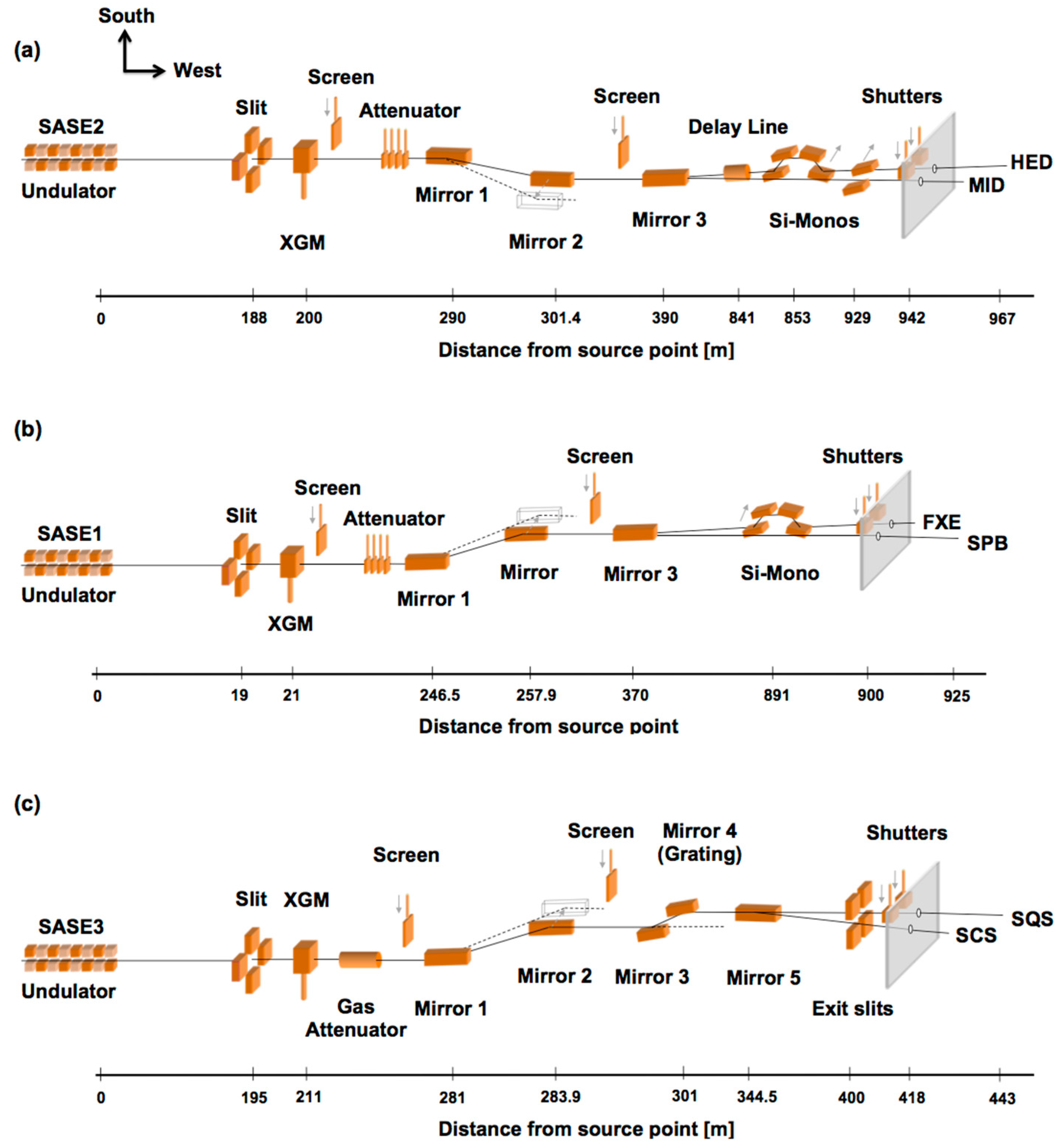
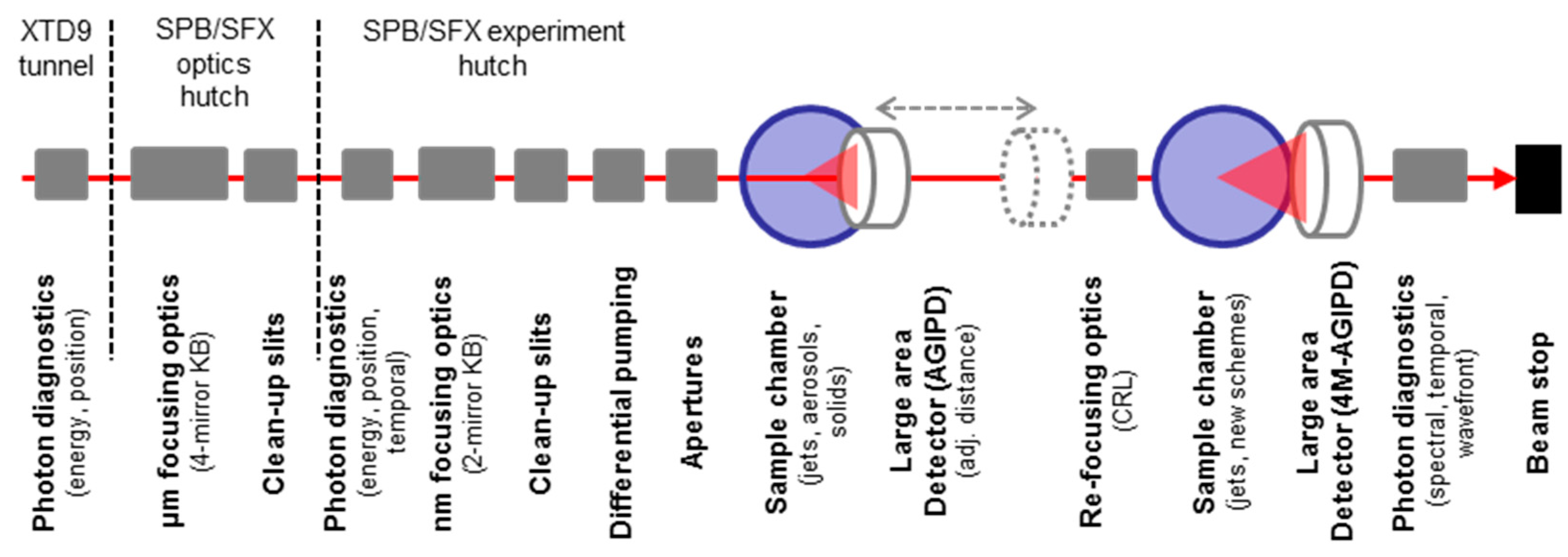
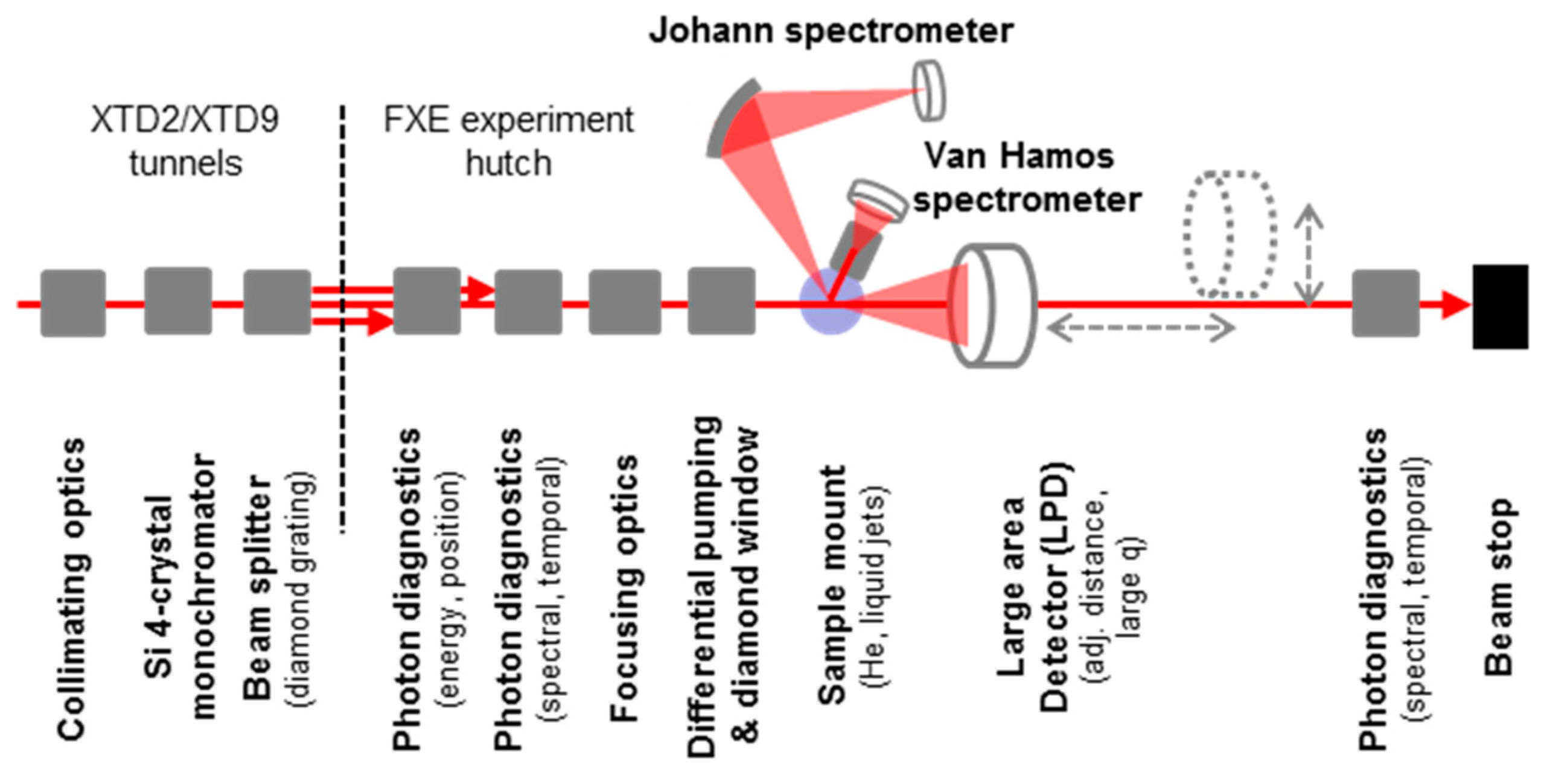
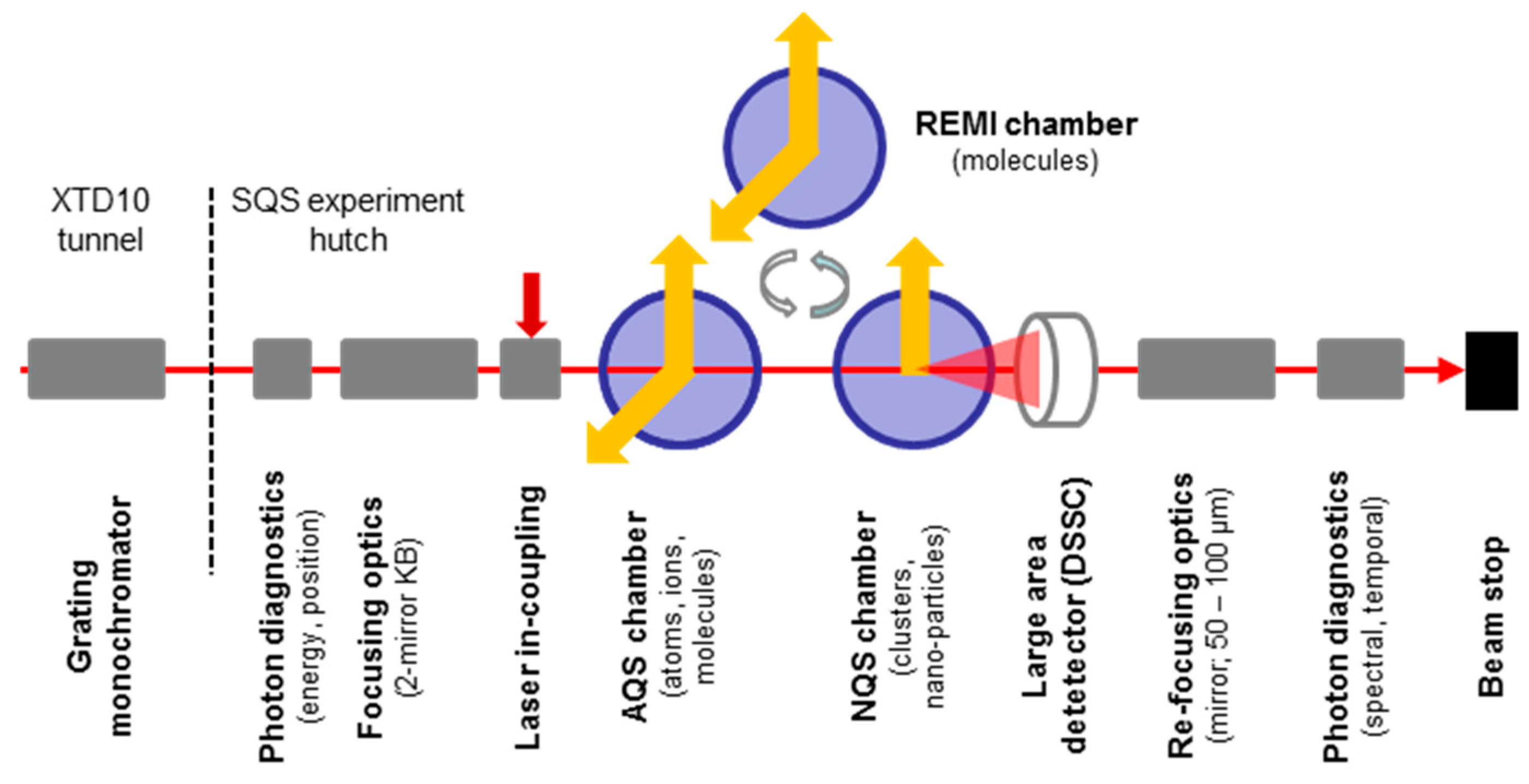
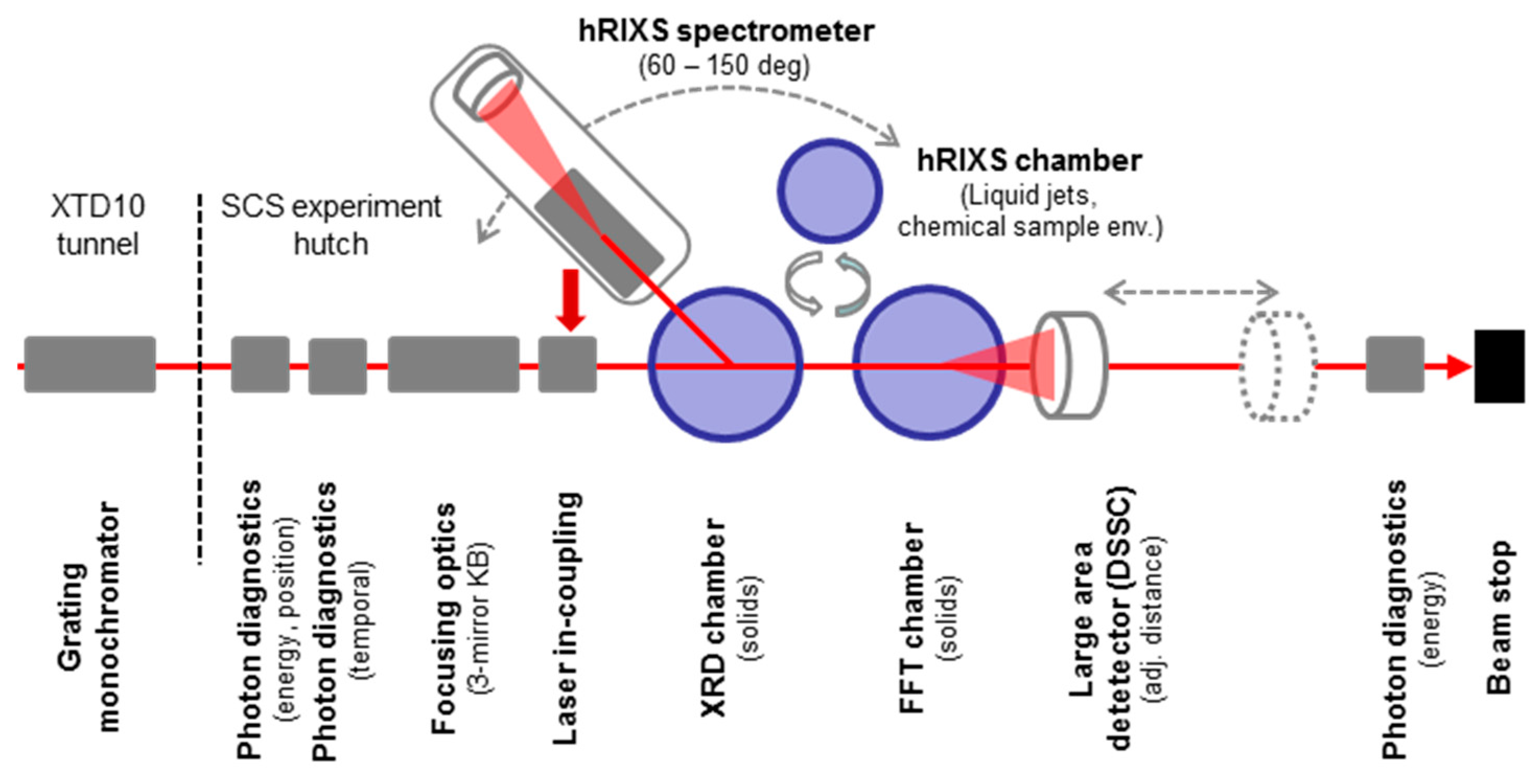
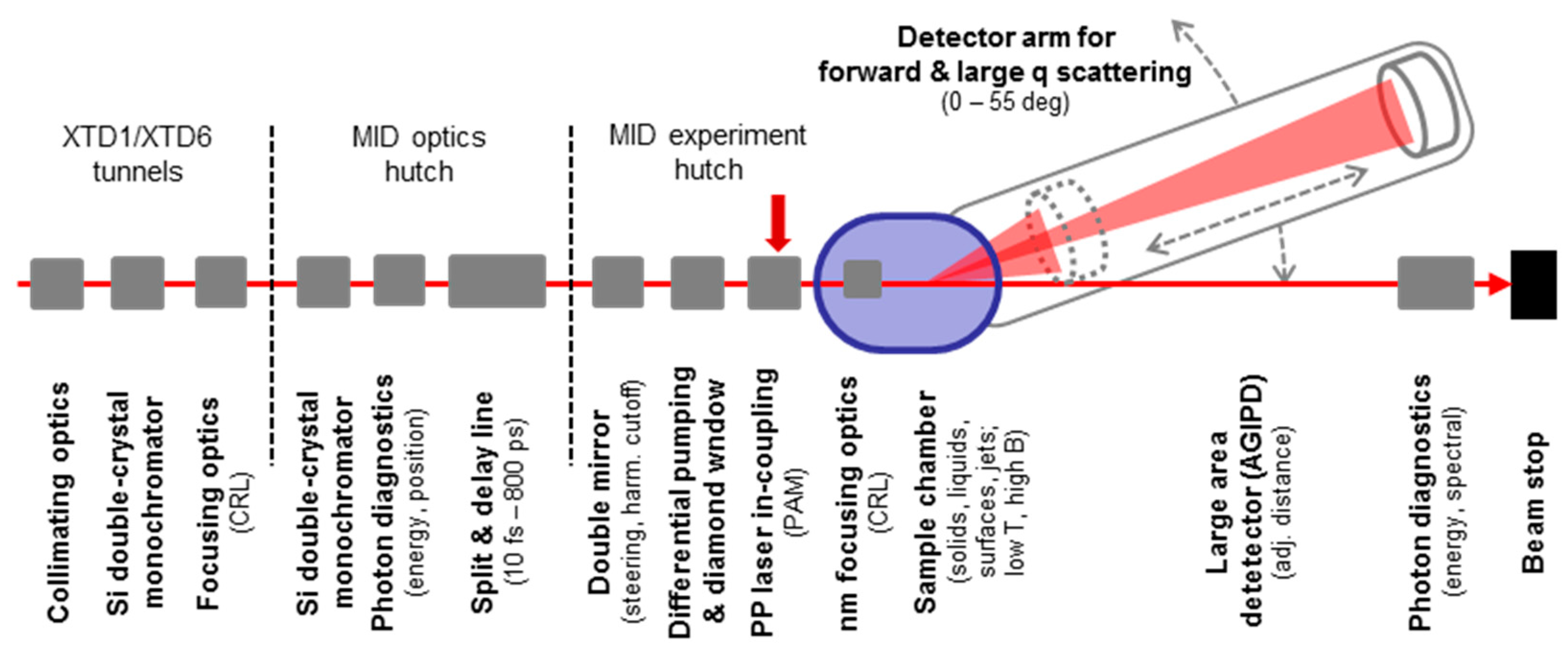
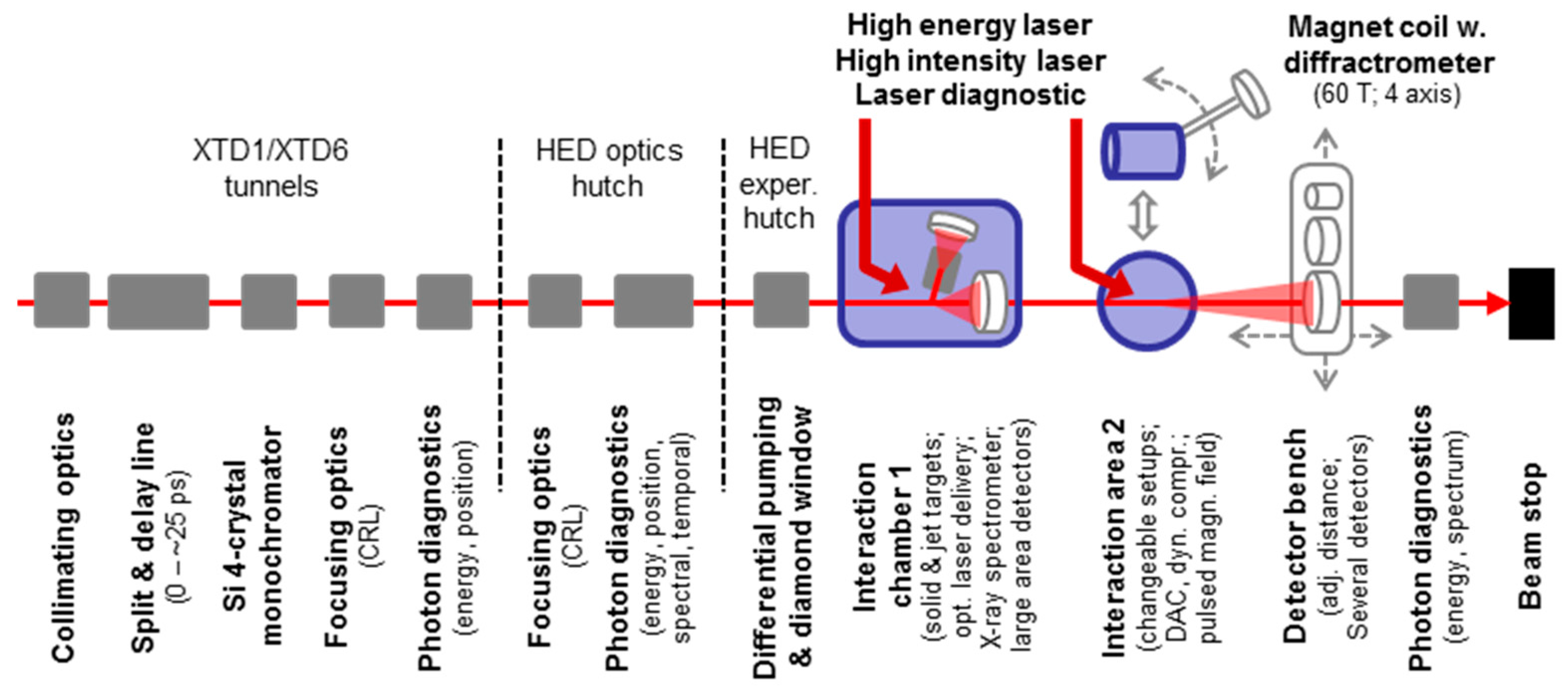
| Parameter | LCLS | SACLA | PAL-XFEL | SwissFEL | European XFEL |
|---|---|---|---|---|---|
| Technology | Warm | Warm | Warm | Warm | Super-conducting |
| Accelerator frequency | 2.856 GHz | 5.7 GHz | 2.856 GHz | 6 GHz | 1.3 GHz |
| Maximum energy | 15 GeV | 8 GeV | 10 GeV | 5.8 GeV | 17.5 GeV |
| Bunch charge | 0.2 nC | 0.2 nC | 0.2 nC | 0.2 nC | 1.0 nC |
| Repetition rate | 120 Hz | 60 Hz | 60 Hz | 100 Hz | 27,000 bunches/s 1 |
| Maximum power 2 | 300 W | 100 W | 100 W | 100 W | 500 kW |
| User operation | 2009 | 2012 | 2017 | 20182 | 2017 |
| Reference | [5] | [7] | [8] | [9] | [14,15] |
| Parameter | SASE1/SASE2 | SASE3 |
|---|---|---|
| Period length (mm) | 40 | 68 |
| Maximum B-field (T; @10 mm) | 1.11 | 1.68 |
| Number of poles per segment | 248 | 146 |
| Number of segments | 35 | 21 |
| Total system length (m) | 205 | 121 |
| Gap range (mm) | 10–20 | 10–25 |
| K-parameter range | 1.65–3.9 | 4–9 |
| Photon energy range (keV; @8.5 GeV) | 1.99 1–7.2 | 0.243–1.08 |
| Photon energy range (keV; @12 GeV) | 3.97–14.5 | 0.485–2.16 |
| Photon energy range (keV; @17.5 GeV) | 8.44–30.8 1 | 1.031–4.6 1 |
| X-ray Beam Energy | 243 eV | 790 eV | 1680 eV | 6.2 keV | 13.3 keV | 30.8 keV 1 |
|---|---|---|---|---|---|---|
| FEL source | SASE3 | SASE3 | SASE3 | SASE1/2 | SASE1/2 | SASE1/2 |
| Electron energy (GeV) | 8.5 | 12 | 17.5 | 12 | 17.5 | 17.5 |
| Bunch charge 0.02 nC | ||||||
| Pulse energy (mJ) | 0.14 | 0.14 | 0.17 | 0.05 | 0.06 | 0.03 |
| Peak brilliance 2 | 5.0 × 1031 | 2.3 × 1032 | 6.9 × 1032 | 1.5 × 1033 | 4.4 × 1033 | 6.4 × 1033 |
| Average intensity 3 | 9.6 × 1016 | 3.0 × 1016 | 1.7 × 1016 | 1.5 × 1015 | 7.7 × 1014 | 1.5 × 1014 |
| Saturation length (m) | 29 | 38 | 47 | 47 | 59 | 101 |
| Bunch charge 0.25 nC | ||||||
| Pulse energy (mJ) | 2.04 | 2.06 | 2.34 | 0.73 | 0.65 | 0.235 |
| Peak brilliance 2 | 5.8 × 1031 | 2.6 × 1032 | 7.9 × 1032 | 1.6 × 1033 | 4.1 × 1033 | 4.1 × 1033 |
| Average intensity 3 | 1.4 × 1018 | 4.4 × 1017 | 2.3 × 1017 | 2.0 × 1016 | 8.3 × 1015 | 1.3 × 1015 |
| Saturation length (m) | 31 | 42 | 52 | 54 | 73 | 161 |
| Bunch charge 1.0 nC | ||||||
| Pulse energy (mJ) | 8.51 | 8.36 | 9.25 | 2.29 | 1.68 | - |
| Peak brilliance 2 | 5.9 × 1031 | 2.6 × 1032 | 7.8 × 1033 | 1.3 × 1033 | 2.4 × 1033 | - |
| Average intensity 3 | 5.9 × 1018 | 1.8 × 1018 | 9.3 × 1017 | 6.2 × 1016 | 2.1 × 1016 | - |
| Saturation length (m) | 35 | 48 | 60 | 68 | 105 | 252 |
© 2017 by the authors. Licensee MDPI, Basel, Switzerland. This article is an open access article distributed under the terms and conditions of the Creative Commons Attribution (CC BY) license (http://creativecommons.org/licenses/by/4.0/).
Share and Cite
Tschentscher, T.; Bressler, C.; Grünert, J.; Madsen, A.; Mancuso, A.P.; Meyer, M.; Scherz, A.; Sinn, H.; Zastrau, U. Photon Beam Transport and Scientific Instruments at the European XFEL. Appl. Sci. 2017, 7, 592. https://doi.org/10.3390/app7060592
Tschentscher T, Bressler C, Grünert J, Madsen A, Mancuso AP, Meyer M, Scherz A, Sinn H, Zastrau U. Photon Beam Transport and Scientific Instruments at the European XFEL. Applied Sciences. 2017; 7(6):592. https://doi.org/10.3390/app7060592
Chicago/Turabian StyleTschentscher, Thomas, Christian Bressler, Jan Grünert, Anders Madsen, Adrian P. Mancuso, Michael Meyer, Andreas Scherz, Harald Sinn, and Ulf Zastrau. 2017. "Photon Beam Transport and Scientific Instruments at the European XFEL" Applied Sciences 7, no. 6: 592. https://doi.org/10.3390/app7060592








